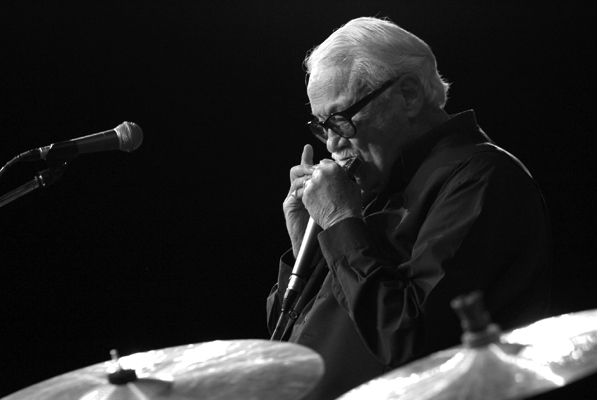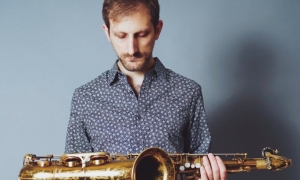Home » Jazz Articles » Interview » Pruning the Tree: Seven Decades of Jazz with Toots Thielemans
Pruning the Tree: Seven Decades of Jazz with Toots Thielemans

Thielemans has won dozens of "best of" awards in Downbeat and other jazz magazines—where his work on harmonica is usually categorized as "Best Miscellaneous Instrument." But as the late trumpeter Clifford brown once told him, "Toots, the way you play the harmonica, they should not call it a miscellaneous instrument!"
In the following telephone conversation from his Brussels home, Thielemans reminisces about his early exposure to jazz and journeying to New York City to become part of the bebop revolution, touches on highlights from his lengthy career- -and talks about his musical relationship with Kenny Werner.
All About Jazz: How did you first get interested in playing the harmonica?
Toots Thielemans: I bought my first harmonica when I was 18 years old on Brussels. I had just finished my six years in secondary school and I had seen Larry Adler—who was pioneering the harmonica—in movies. So that gave me the idea to buy one. But I just wanted it to play popular songs as a hobby. At that time I didn't know about jazz.
AAJ When did you first discover jazz?
TT: It was 1942 during the German occupation. I can't say whether I discovered jazz or jazz discovered me! Ask many musicians and they won't know what to answer. Let's put it this way—I caught the jazz virus. It happened when I bought a record by Louis Armstrong and the Mills Brothers from the late 1930s. That's how far back I go. During the German occupation, we only had access to recordings done before 1940. So then I wanted to play jazz, but the musicians in Belgium told me to throw that toy away—meaning the harmonica—and get a real instrument.
AAJ And that's when you began playing guitar?
TT: Yes. Accidentally through a friend I got a guitar. And in those days, the inspiration for jazz guitar—especially in Europe—was Django Reinhardt and his recordings with Stephane Grappelli at the Hot Club in Paris. I had an old windup phonograph—I still have it—that I used to play his records. I took three guitar lessons, and then listened to those records over and over to teach myself how to play.
AAJ When did you start playing music professionally?
TT: I had been planning on being a mathematics teacher, but after I played professionally for the first time at the end of the occupation in 1944, earning my first $10 playing guitar in a tearoom, I decided to concentrate on music. Then when the bebop explosion happened at the end of the War, I knew I wanted to go to the United States and be a part of that.
AAJ Your first visit to America was in 1947, right?
TT: I came as a tourist with my uncle—my father's brother. As it happened, my last two days in New York City before I cam back to Brussels I had the chance to play on 52nd Street, which was the center for jazz. Bill Gottlieb, the famous jazz photographer had happened to hear me sitting in during a jam session in Miami, where my uncle and I first went on our trip. When we got to New York City, we met up with him and he introduced me to Howard McGhee— who was a fine trumpet player who was leading an all-star group at the Three Deuces—sharing the bill with pianist Lennie Tristano and his trio. Some of the other musicians in Howard's band were Hank Jones, Milt Jackson and J.J. Johnson. Bill told them, "I've got this guy from Belgium who plays harmonica." Their reaction was, "Oh..." But I was accepted and got to sit in. An agent named Billy Shaw happened to be there as well, and after I got back to Brussels I would send him homemade recordings. He passed one of them along to Benny Goodman, it wound up on his turntable, and that's how I got the chance to tour with the Goodman band in Europe in 1950. But I couldn't continue with the band back to the States, because I still didn't have a visa.
AAJ In 1949 you also had the chance to meet Charlie Parker and Miles Davis at a festival in Paris, didn't you?
TT: I was representing Belgium with a trio and somehow I was in the same festival with Charlie Parker, who was playing with Kenny Dorham and Al Haig, and Miles, who was with James Moody, Tad Dameron and Kenny Clarke! I ended up staying and playing in Paris after that until I played with Benny Goodman the next year. I was finally able to get my visa and come to America in 1952.
AAJ You joined pianist George Shearing's quintet soon after you arrived. How did Shearing end up hiring you?
TT: That's a good story! In those days, I was trying hard to meet the jazz musicians in New York and it was hard to open doors. There were a few bars that were meeting places for musicians, like Junior's, which was right across from Birdland, and Jin & Andy's. In those days there were a lot of recording sessions, and guys would be doing three hours for Sinatra, another hour for a commercial, and meeting at these places in between. I was at a bar across from the Metropole, where Gene Krupa was playing, and Tony Scott, who was a clarinet and saxophonist, came in. I had already played a couple of Monday night sessions at Birdland—sitting in with Lockjaw Davis—and Tony must have heard me. In his very exuberant way, he told me he liked my harmonica playing, and asked me if I played the guitar too.
Tony was sort a jazz chamber of commerce back then, always trying to help a little cat from Minnesota—or Europe—trying to find a place to play in New York City. He said, "You got your harmonica with you? Come with me," and we walked up to Carnegie Hall. George Shearing's group was playing there on a double bill, opening for Billy Eckstine. Tony practically broke down the stage door, telling them he had to see George Shearing. Anyway, we got in; he took me to see George and introduced me, telling George, "Wait till you hear this guy!" I played "Body and soul right there in his dressing room, and when I was finished, Tony told him, "This guy plays the guitar too, George!" Tony knew that George's guitarist Dick Garcia, was going into the army. A week after that meeting, Shearing was playing the Rendezvous Club in Philadelphia, and I was playing with Charlie Parker's All-Stars, opening for Dinah Washington in Philadelphia at the same time. During one of the breaks, I took my guitar over to the club to audition for George. He hired me and I played with him for six years.
AAJ You also have had a long relationship with Quincy Jones over the years, playing on many of his recordings.
TT: I met Quincy when I was still with Shearing, and he was playing third trumpet with Lionel Hampton. We became friends, and more than ten years later when Quincy was doing his first movie soundtrack in Hollywood, he asked me to come out and play on it. Later, in the mid-sixties when he started doing solo albums for Creed Taylor, he called me again to record with Ray Brown, Freddie Hubbard and Herbie Hancock. By that time I had already recorded Bluesette, which was me whistling and playing guitar at the same time. Back then, I really didn't want to travel so much. So that meant I had to do commercials, play bar mitzvahs and do things like the Dick Cavett TV show. I ended up doing really well in the studio, but I was doing everything but jazz. I told him that I hadn't played jazz in a year and I didn't think I could do it anymore. Basically, he told me I had to be at Rudy Van Gelder's studio in New Jersey at 9 o'clock. So he got me back into jazz, and he still calls me for sessions today.
AAJ In the 1990s, you recorded The Brasil Project , two volumes of music featuring you with musicians such as Ivan Lins, Milton Nascimento and Gilberto Gil. What is there about Brazilian music that attracts you?
TT: I first went to Brazil in 1972 to work with the singer, Elis Regina. But I've always felt that in the harmonies of Brazilian music—especially bossa nova—there are great similarities to bebop. And on Jobim compositions like "One Note Samba" and "Wave," the melodies are based on bebop chords. Brazilian composers like Jobim and Lins are melodic geniuses—they write melody that lasts. Charlie parker and the other beboppers wrote themes, but nobody outside of a jazz scat singer sings those. So that evolution in jazz harmony and melody is what attracted me to Brazilian music.
AAJ You've played with Kenny Werner since 1995. How did that musical relationship evolve?
TT: The singer Judy Niemack was in the States to do a recording and Kenny was the producer. She asked me to come and play on a session. That was my first contact with Kenny, and I made sure to get his phone number. I had been working a lot with pianist Fred Hersch—for many years I didn't make a move without Fred. But he was getting his own group together, and I started working with Kenny.
AAJ You and Kenny seem to have a special rapport—one that transcends any generational boundaries.
TT: Well, I think we both have a love of melody. You know, some of the younger musicians play all the notes and can do it very fast and are clever with scales. But in these fast flurries of notes, no melody comes out— at least to my ears. Kenny tells me that sometimes he tells young guys like that, "You cannot play a melody. Buy a bunch of Toots Thielemans records and learn how to do that." Clever notes and chords are not necessarily music. And clever words and expressions are not necessarily poetry.
AAJ When I saw you in St. Louis in 2001, you brought your guitar, but you only played it on one song in the set. Will you be playing more guitar on this tour?
TT: My left side is still a little weak from a stroke I had several years ago, but many of my friends encourage me when I tell them I can't play that many notes on guitar. They say it's quality, not quantity. That counts. You know, jazz is a language, and I've been trying to speak that language as a professional musician for sixty years. Every so often a giant comes along like Coltrane or Dizzy and adds new words to the language. So you always have to keep practicing. John Scofield called me the other day and he calls it "pruning the tree." So everyday I practice and keep pruning.
Photo Credit: Guy Fonck
Tags
PREVIOUS / NEXT
Support All About Jazz
 All About Jazz has been a pillar of jazz since 1995, championing it as an art form and, more importantly, supporting the musicians who make it. Our enduring commitment has made "AAJ" one of the most culturally important websites of its kind, read by hundreds of thousands of fans, musicians and industry figures every month.
All About Jazz has been a pillar of jazz since 1995, championing it as an art form and, more importantly, supporting the musicians who make it. Our enduring commitment has made "AAJ" one of the most culturally important websites of its kind, read by hundreds of thousands of fans, musicians and industry figures every month.




















